Yukun Bao
Reinforced Decoder: Towards Training Recurrent Neural Networks for Time Series Forecasting
Jun 14, 2024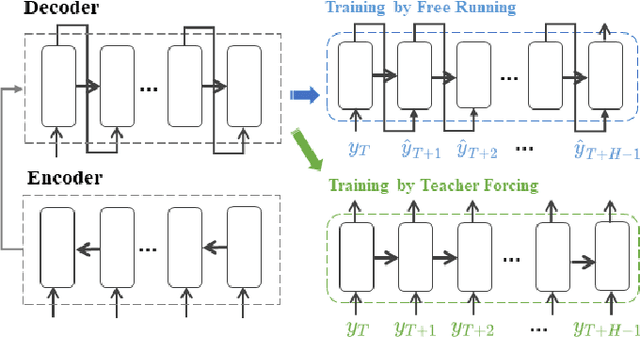
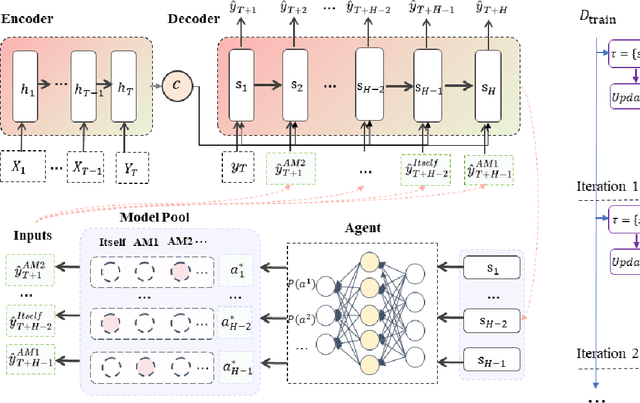
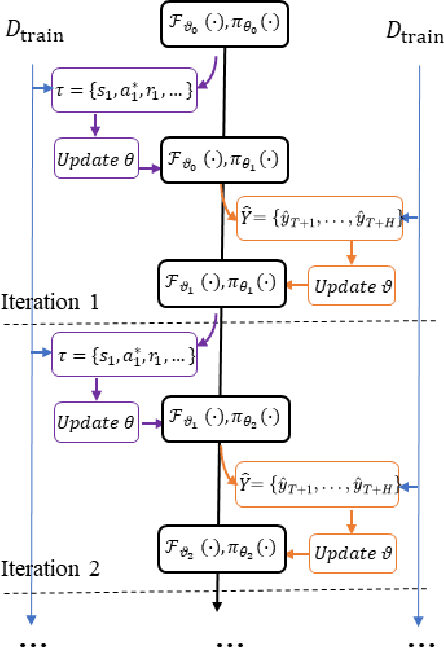

Abstract:Recurrent neural network-based sequence-to-sequence models have been extensively applied for multi-step-ahead time series forecasting. These models typically involve a decoder trained using either its previous forecasts or the actual observed values as the decoder inputs. However, relying on self-generated predictions can lead to the rapid accumulation of errors over multiple steps, while using the actual observations introduces exposure bias as these values are unavailable during the extrapolation stage. In this regard, this study proposes a novel training approach called reinforced decoder, which introduces auxiliary models to generate alternative decoder inputs that remain accessible when extrapolating. Additionally, a reinforcement learning algorithm is utilized to dynamically select the optimal inputs to improve accuracy. Comprehensive experiments demonstrate that our approach outperforms representative training methods over several datasets. Furthermore, the proposed approach also exhibits promising performance when generalized to self-attention-based sequence-to-sequence forecasting models.
A novel MDPSO-SVR hybrid model for feature selection in electricity consumption forecasting
Jun 14, 2022



Abstract:Electricity consumption forecasting has vital importance for the energy planning of a country. Of the enabling machine learning models, support vector regression (SVR) has been widely used to set up forecasting models due to its superior generalization for unseen data. However, one key procedure for the predictive modeling is feature selection, which might hurt the prediction accuracy if improper features were selected. In this regard, a modified discrete particle swarm optimization (MDPSO) was employed for feature selection in this study, and then MDPSO-SVR hybrid mode was built to predict future electricity consumption. Compared with other well-established counterparts, MDPSO-SVR model consistently performs best in two real-world electricity consumption datasets, which indicates that MDPSO for feature selection can improve the prediction accuracy and the SVR equipped with the MDPSO can be a promised alternative for electricity consumption forecasting.
Multivariate Empirical Mode Decomposition based Hybrid Model for Day-ahead Peak Load Forecasting
Oct 28, 2021



Abstract:Accurate day-ahead peak load forecasting is crucial not only for power dispatching but also has a great interest to investors and energy policy maker as well as government. Literature reveals that 1% error drop of forecast can reduce 10 million pounds operational cost. Thus, this study proposed a novel hybrid predictive model built upon multivariate empirical mode decomposition (MEMD) and support vector regression (SVR) with parameters optimized by particle swarm optimization (PSO), which is able to capture precise electricity peak load. The novelty of this study mainly comes from the application of MEMD, which enables the multivariate data decomposition to effectively extract inherent information among relevant variables at different time frequency during the deterioration of multivariate over time. Two real-world load data sets from the New South Wales (NSW) and the Victoria (VIC) in Australia have been considered to verify the superiority of the proposed MEMD-PSO-SVR hybrid model. The quantitative and comprehensive assessments are performed, and the results indicate that the proposed MEMD-PSO-SVR method is a promising alternative for day-ahead electricity peak load forecasting.
Comprehensive learning particle swarm optimization enabled modeling framework for multi-step-ahead influenza prediction
Oct 27, 2021



Abstract:Epidemics of influenza are major public health concerns. Since influenza prediction always relies on the weekly clinical or laboratory surveillance data, typically the weekly Influenza-like illness (ILI) rate series, accurate multi-step-ahead influenza predictions using ILI series is of great importance, especially, to the potential coming influenza outbreaks. This study proposes Comprehensive Learning Particle Swarm Optimization based Machine Learning (CLPSO-ML) framework incorporating support vector regression (SVR) and multilayer perceptron (MLP) for multi-step-ahead influenza prediction. A comprehensive examination and comparison of the performance and potential of three commonly used multi-step-ahead prediction modeling strategies, including iterated strategy, direct strategy and multiple-input multiple-output (MIMO) strategy, was conducted using the weekly ILI rate series from both the Southern and Northern China. The results show that: (1) The MIMO strategy achieves the best multi-step-ahead prediction, and is potentially more adaptive for longer horizon; (2) The iterated strategy demonstrates special potentials for deriving the least time difference between the occurrence of the predicted peak value and the true peak value of an influenza outbreak; (3) For ILI in the Northern China, SVR model implemented with MIMO strategy performs best, and SVR with iterated strategy also shows remarkable performance especially during outbreak periods; while for ILI in the Southern China, both SVR and MLP models with MIMO strategy have competitive prediction performance
Error-feedback Stochastic Configuration Strategy on Convolutional Neural Networks for Time Series Forecasting
Feb 03, 2020



Abstract:Despite the superiority of convolutional neural networks demonstrated in time series modeling and forecasting, it has not been fully explored on the design of the neural network architecture as well as the tuning of the hyper-parameters. Inspired by the iterative construction strategy for building a random multilayer perceptron, we propose a novel Error-feedback Stochastic Configuration (ESC) strategy to construct a random Convolutional Neural Network (ESC-CNN) for time series forecasting task, which builds the network architecture adaptively. The ESC strategy suggests that random filters and neurons of the error-feedback fully connected layer are incrementally added in a manner that they can steadily compensate the prediction error during the construction process, and a filter selection strategy is introduced to secure that ESC-CNN holds the universal approximation property, providing helpful information at each iterative process for the prediction. The performance of ESC-CNN is justified on its prediction accuracy for one-step-ahead and multi-step-ahead forecasting tasks. Comprehensive experiments on a synthetic dataset and two real-world datasets show that the proposed ESC-CNN not only outperforms the state-of-art random neural networks, but also exhibits strong predictive power in comparison to trained Convolution Neural Networks and Long Short-Term Memory models, demonstrating the effectiveness of ESC-CNN in time series forecasting.
Identifying Malicious Web Domains Using Machine Learning Techniques with Online Credibility and Performance Data
Feb 23, 2019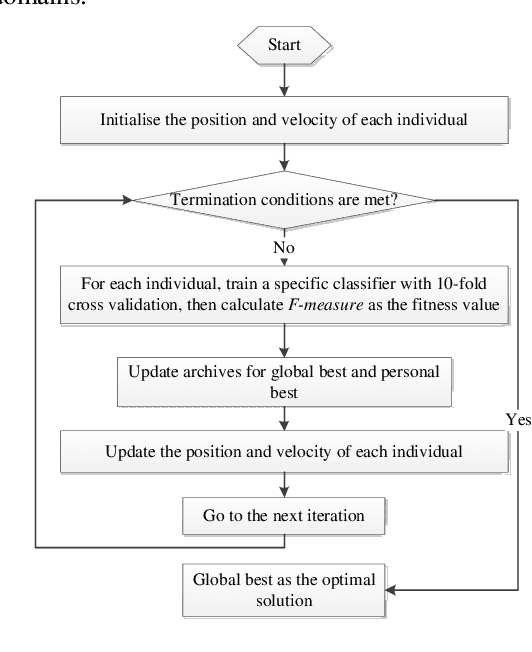
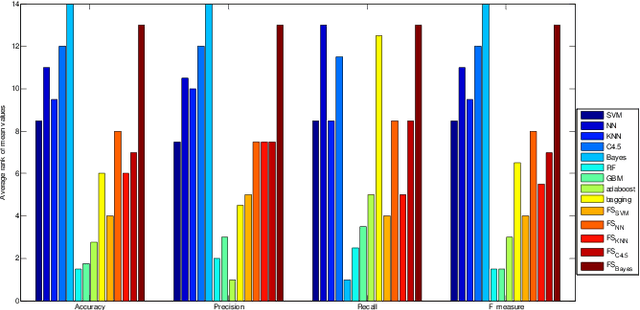
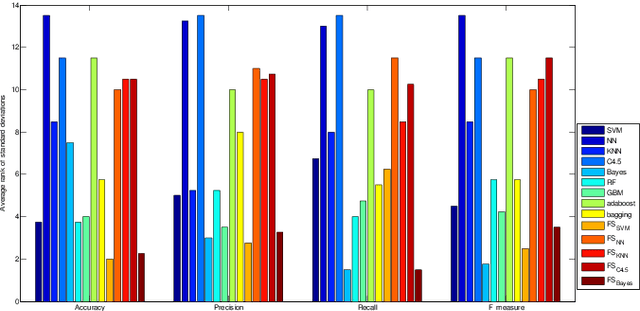

Abstract:Malicious web domains represent a big threat to web users' privacy and security. With so much freely available data on the Internet about web domains' popularity and performance, this study investigated the performance of well-known machine learning techniques used in conjunction with this type of online data to identify malicious web domains. Two datasets consisting of malware and phishing domains were collected to build and evaluate the machine learning classifiers. Five single classifiers and four ensemble classifiers were applied to distinguish malicious domains from benign ones. In addition, a binary particle swarm optimisation (BPSO) based feature selection method was used to improve the performance of single classifiers. Experimental results show that, based on the web domains' popularity and performance data features, the examined machine learning techniques can accurately identify malicious domains in different ways. Furthermore, the BPSO-based feature selection procedure is shown to be an effective way to improve the performance of classifiers.
* 10 pages, conference
Malicious Web Domain Identification using Online Credibility and Performance Data by Considering the Class Imbalance Issue
Oct 19, 2018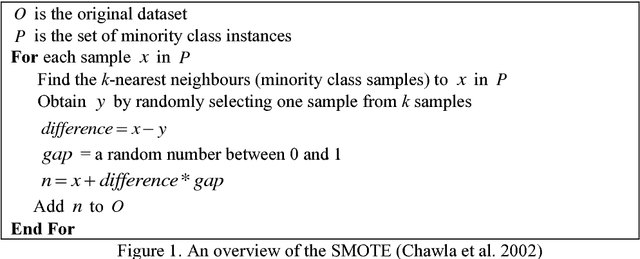

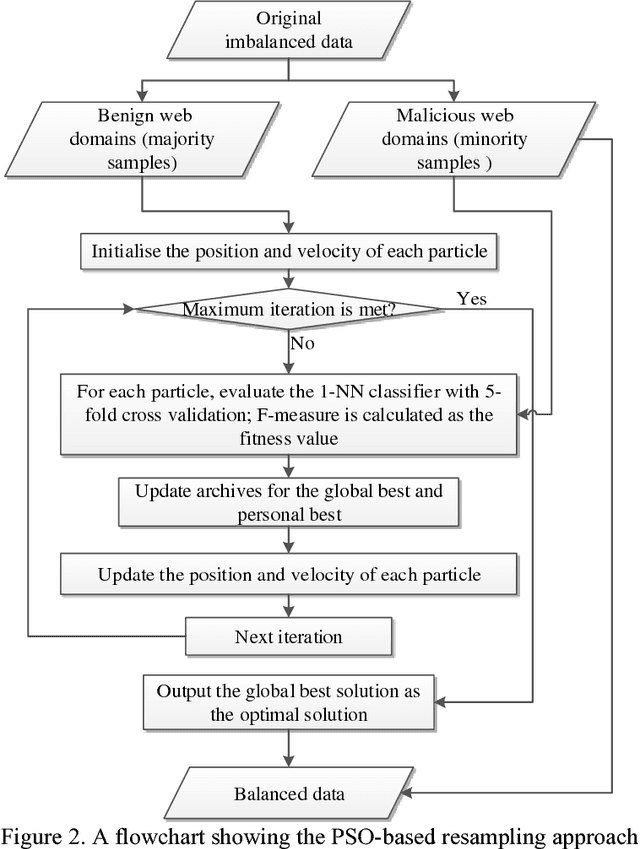
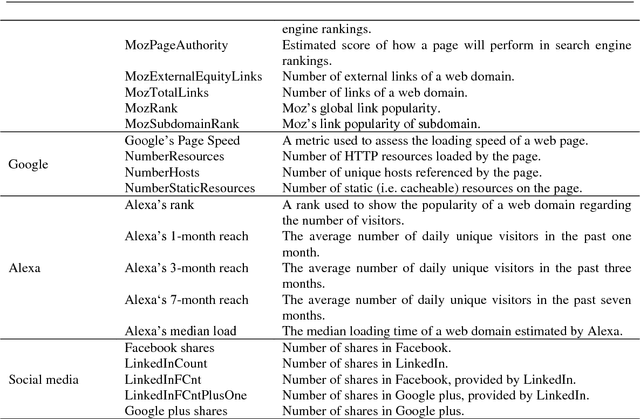
Abstract:Purpose: Malicious web domain identification is of significant importance to the security protection of Internet users. With online credibility and performance data, this paper aims to investigate the use of machine learning tech-niques for malicious web domain identification by considering the class imbalance issue (i.e., there are more benign web domains than malicious ones). Design/methodology/approach: We propose an integrated resampling approach to handle class imbalance by combining the Synthetic Minority Over-sampling TEchnique (SMOTE) and Particle Swarm Optimisation (PSO), a population-based meta-heuristic algorithm. We use the SMOTE for over-sampling and PSO for under-sampling. Findings: By applying eight well-known machine learning classifiers, the proposed integrated resampling approach is comprehensively examined using several imbalanced web domain datasets with different imbalance ratios. Com-pared to five other well-known resampling approaches, experimental results confirm that the proposed approach is highly effective. Practical implications: This study not only inspires the practical use of online credibility and performance data for identifying malicious web domains, but also provides an effective resampling approach for handling the class imbal-ance issue in the area of malicious web domain identification. Originality/value: Online credibility and performance data is applied to build malicious web domain identification models using machine learning techniques. An integrated resampling approach is proposed to address the class im-balance issue. The performance of the proposed approach is confirmed based on real-world datasets with different imbalance ratios.
* 20 pages
Interval Forecasting of Electricity Demand: A Novel Bivariate EMD-based Support Vector Regression Modeling Framework
Jun 15, 2014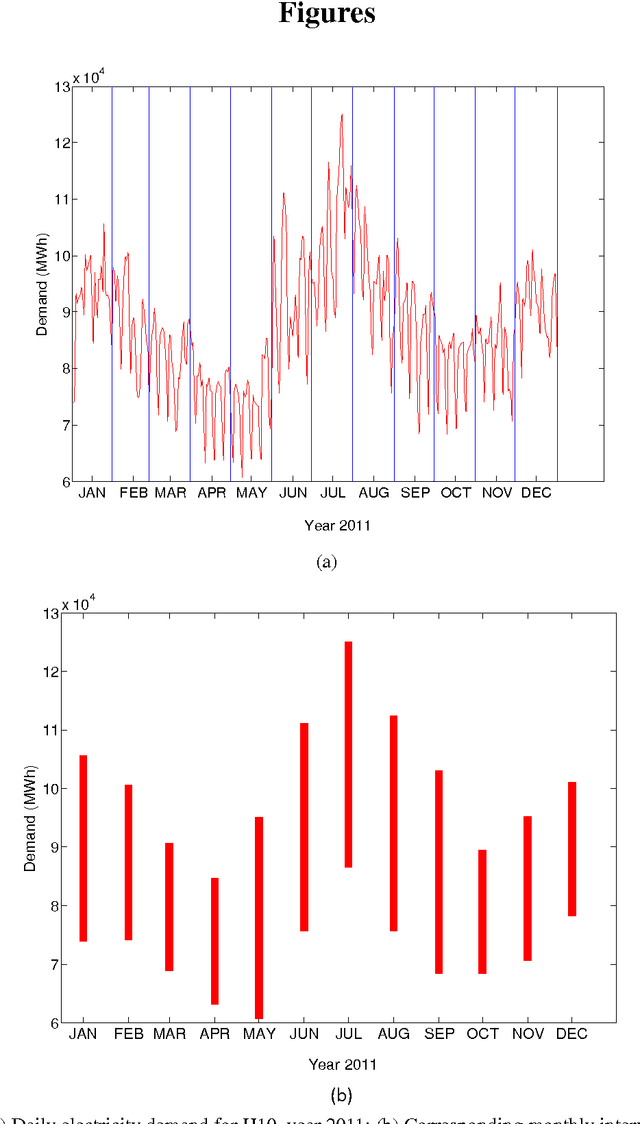
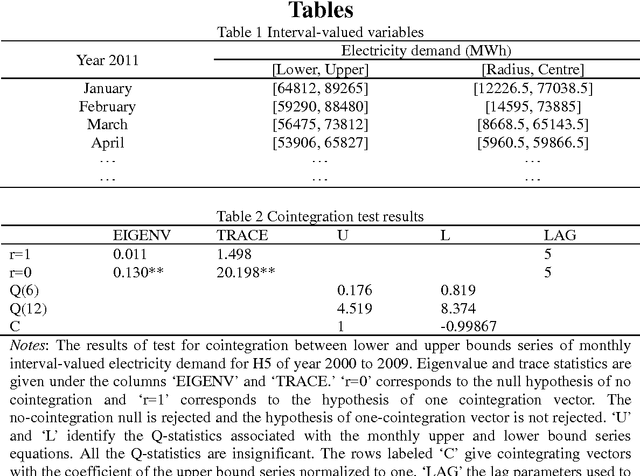
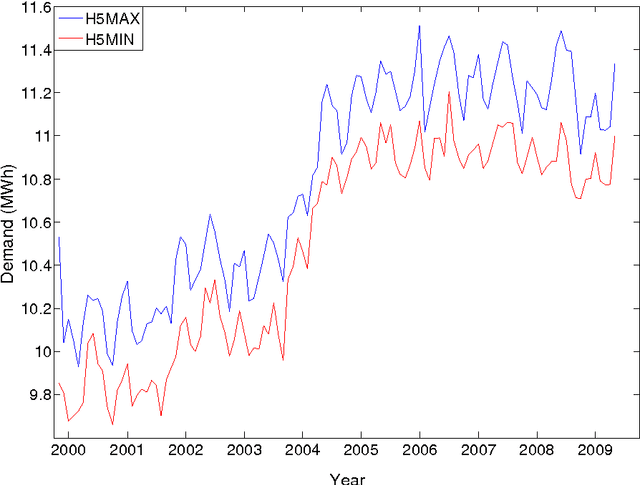
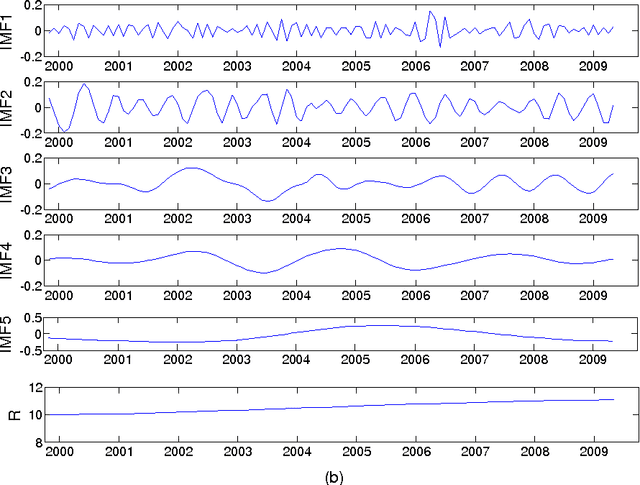
Abstract:Highly accurate interval forecasting of electricity demand is fundamental to the success of reducing the risk when making power system planning and operational decisions by providing a range rather than point estimation. In this study, a novel modeling framework integrating bivariate empirical mode decomposition (BEMD) and support vector regression (SVR), extended from the well-established empirical mode decomposition (EMD) based time series modeling framework in the energy demand forecasting literature, is proposed for interval forecasting of electricity demand. The novelty of this study arises from the employment of BEMD, a new extension of classical empirical model decomposition (EMD) destined to handle bivariate time series treated as complex-valued time series, as decomposition method instead of classical EMD only capable of decomposing one-dimensional single-valued time series. This proposed modeling framework is endowed with BEMD to decompose simultaneously both the lower and upper bounds time series, constructed in forms of complex-valued time series, of electricity demand on a monthly per hour basis, resulting in capturing the potential interrelationship between lower and upper bounds. The proposed modeling framework is justified with monthly interval-valued electricity demand data per hour in Pennsylvania-New Jersey-Maryland Interconnection, indicating it as a promising method for interval-valued electricity demand forecasting.
Multi-Step-Ahead Time Series Prediction using Multiple-Output Support Vector Regression
Jan 11, 2014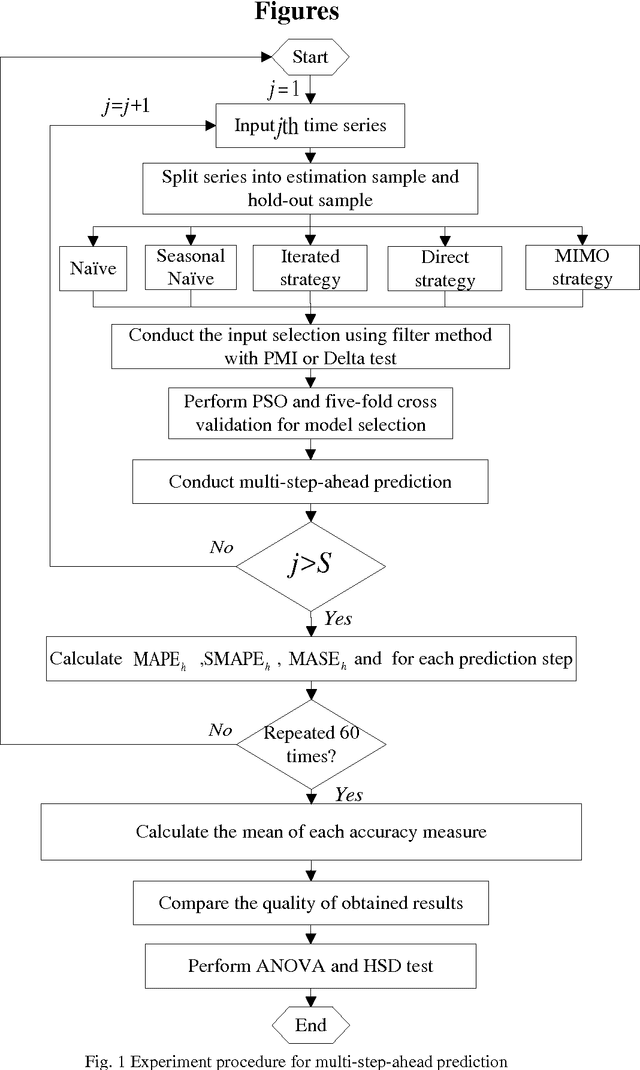
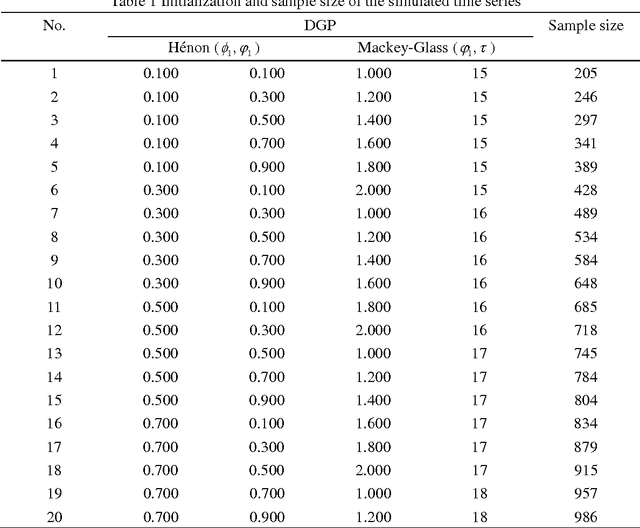
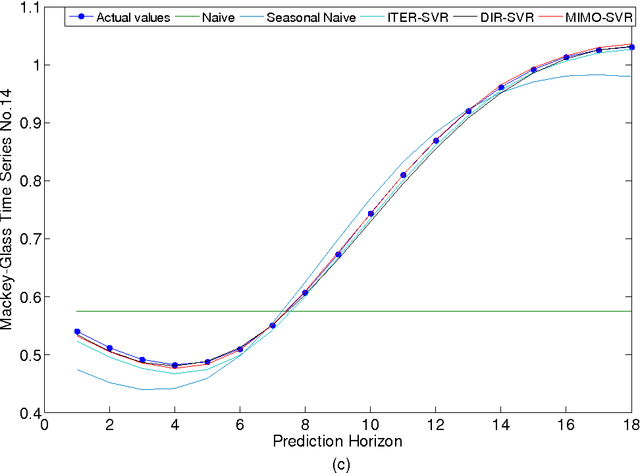

Abstract:Accurate time series prediction over long future horizons is challenging and of great interest to both practitioners and academics. As a well-known intelligent algorithm, the standard formulation of Support Vector Regression (SVR) could be taken for multi-step-ahead time series prediction, only relying either on iterated strategy or direct strategy. This study proposes a novel multiple-step-ahead time series prediction approach which employs multiple-output support vector regression (M-SVR) with multiple-input multiple-output (MIMO) prediction strategy. In addition, the rank of three leading prediction strategies with SVR is comparatively examined, providing practical implications on the selection of the prediction strategy for multi-step-ahead forecasting while taking SVR as modeling technique. The proposed approach is validated with the simulated and real datasets. The quantitative and comprehensive assessments are performed on the basis of the prediction accuracy and computational cost. The results indicate that: 1) the M-SVR using MIMO strategy achieves the best accurate forecasts with accredited computational load, 2) the standard SVR using direct strategy achieves the second best accurate forecasts, but with the most expensive computational cost, and 3) the standard SVR using iterated strategy is the worst in terms of prediction accuracy, but with the least computational cost.
Does Restraining End Effect Matter in EMD-Based Modeling Framework for Time Series Prediction? Some Experimental Evidences
Jan 11, 2014Abstract:Following the "decomposition-and-ensemble" principle, the empirical mode decomposition (EMD)-based modeling framework has been widely used as a promising alternative for nonlinear and nonstationary time series modeling and prediction. The end effect, which occurs during the sifting process of EMD and is apt to distort the decomposed sub-series and hurt the modeling process followed, however, has been ignored in previous studies. Addressing the end effect issue, this study proposes to incorporate end condition methods into EMD-based decomposition and ensemble modeling framework for one- and multi-step ahead time series prediction. Four well-established end condition methods, Mirror method, Coughlin's method, Slope-based method, and Rato's method, are selected, and support vector regression (SVR) is employed as the modeling technique. For the purpose of justification and comparison, well-known NN3 competition data sets are used and four well-established prediction models are selected as benchmarks. The experimental results demonstrated that significant improvement can be achieved by the proposed EMD-based SVR models with end condition methods. The EMD-SBM-SVR model and EMD-Rato-SVR model, in particular, achieved the best prediction performances in terms of goodness of forecast measures and equality of accuracy of competing forecasts test.
* 28 pages
 Add to Chrome
Add to Chrome Add to Firefox
Add to Firefox Add to Edge
Add to Edge